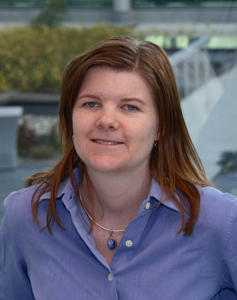- Home
- /
- UAlbany News
- /
- Release
- /
UAlbany, GE Partner to Study Salivary Gland Development, Disorders
Contact(s): Catherine Herman (518) 956-8150
 |
UAlbany Professor Melinda Larsen will offer new insights into cellular signaling during complex developmental processes and highlight the use of this technology in areas beyond cancer drug discovery. |
ALBANY, N.Y. (December 2, 2009) -- University at Albany researcher Melinda Larsen, Department of Biological Sciences, was awarded a two-year, $600,000 stimulus grant through the National Institutes of Health (NIH) Challenge program to examine salivary gland development to provide insight into the root causes of gland disorders, including the inability to produce saliva. For the Salivary Gland Protein Profiling Project, Larsen will collaborate with a team of scientists at GE�s Global Research Center in Niskayuna, N.Y., led by Michael Gerdes, a cancer cell biologist in the Center�s Biosciences organization and adjunct professor at UAlbany�s Department of Biological Sciences.
The consequences of salivary gland damage can have a devastating effect on a person�s quality of life, including increased infections, difficulty swallowing and speaking, and chronic pain. This project will provide insight into how salivary glands could be regenerated after facial trauma or chemotherapy damage. It will also support a more comprehensive program to improve oral health, which is being driven by the National Institute of Dental and Craniofacial Research (NIDCR), part of the NIH.
GE scientists have developed new molecular pathology technology that can create a visual map of more than 25 proteins within a single tissue sample at the sub-cellular level and apply sophisticated imaging analysis tools to collect and interpret the data. With the ability to study multiple proteins in one sample, GE�s technology could provide more insight than ever before into the signaling networks and cell activity characterizing salivary gland disorders and other diseases.
�It is critical to understand how glands develop in order to design therapeutics to regenerate or replace tissue damaged by disease or injury,� said Larsen. �With this study, we will not only gain insight into how glands develop and also produce a set of tools that will be applied to understanding disease.�
GE�s protein mapping technology is the same platform being used in an ongoing cancer research partnership with Eli Lilly and Company, in which the two companies have demonstrated the ability to visualize and map complex biomarker networks in cancer tissue samples. This could enable faster drug development at less cost and more personalized therapies.
�The use of the GE�s protein mapping technology on this project demonstrates the broader application it can have in biomedical research and discovery,� said Gerdes. �The studies being done by Dr. Larsen will offer new insights into cellular signaling during complex developmental processes and highlight the use of this technology in areas beyond cancer drug discovery. We�re proud to be working with the University at Albany to test our technologies in new application areas and to aid in advancing basic research.�
Larsen�s research on the salivary gland is also being supported by additional funding through the National Institutes of Health, National Institute of Dental and Craniofacial Research. In 2008, she was awarded a five-year, $1.5 million grant to develop a mathematical model to describe and predict salivary gland development and a two-year, $400,000 grant to engineer scaffold material to support growth and saliva production by salivary gland cells in vitro.
Saliva is the product of secretions produced by both major and minor salivary glands. Saliva production can be compromised as the result of Sjogren�s syndrome, the second most common autoimmune disease in the United States. This disease affects two to four million people, 90 percent of whom are women. In Sjogren�s syndrome, the body�s immune system attacks the saliva-producing salivary gland cells as well as other fluid-producing cells in the body. Radiation therapy also destroys these cells.
The lack of saliva causes a number of complications that considerably decreases a person�s quality of life, including increased tooth decay and infections, difficulty in swallowing and speaking, and considerable pain Little is known about the causes of salivary gland destruction due to Sjogrens syndrome and radiation treatment. Current treatments are insufficient and no cures exist for either condition.
�The collaboration between GE and UAlbany scientists is a sterling example of how a high-level research university can partner with industry to benefit the economic and scientific profile of the region,� said James Dias, Interim Vice President for Research at UAlbany. �In turn, the benefits of leading-edge technology developed by GE and accessed by UAlbany�s researchers before it becomes a mainstream tool provide a win-win relationship, while advancing the research mission and competitiveness of UAlbany researchers.�
About GE Global Research
GE Global Research is one of the world's most diversified industrial research labs, providing innovative technology for all of GE's businesses. Global Research has been the cornerstone of GE technology for more than 100 years, developing breakthrough innovations in areas such as medical imaging, energy generation technology, jet engines and lighting. GE Global Research is headquartered in Niskayuna, New York and has facilities in Bangalore, India, Shanghai, China and Munich, Germany.
![]() For more news, subscribe to UAlbany's RSS headline feeds
For more news, subscribe to UAlbany's RSS headline feeds
Educationally and culturally, the University at Albany-SUNY puts "The World Within Reach" for its 18,000 students. An internationally recognized research university with 58 undergraduate majors and 128 graduate degree programs, UAlbany is a leader among all New York State colleges and universities in such diverse fields as public policy, nanotechnology and criminal justice. With a curriculum enhanced by 300 study-abroad opportunities, UAlbany launches great careers. For more information about this globally ranked University, visit www.albany.edu. For UAlbany's extensive roster of faculty experts, visit www.albany.edu/news/experts.shtml.


